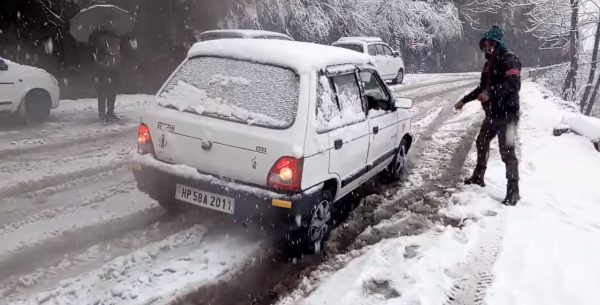Winter driving tips, How to drive safely in snow?
Winter is almost here and going by the reports so far, it’s going to be a cold one. Now while you prepare to shield against the harsh weather, what about your car? Not only does it need some prep to deal with the conditions but also, you need to take some precautions and keep certain things in mind in order to drive safely in winter.
The first step is to get your vehicle ready for the harsh conditions. Get it checked and serviced and replace parts which show above average levels of wear and tear. Do not skimp on this as it will reduce the chances of your vehicle breaking down in cold, icy conditions.
Clean the car: Clean all windows and the wing mirrors with lukewarm water to get rid of ice or snow and ensure good visibility. Do not pour hot water directly as the sudden temperature difference can cause them to crack. Clean the headlamps and tail-lamps too. If there’s snow on the roof, then remove to prevent it from rolling down the front windscreen under hard braking.
Electricals: Check if all lights including indicators and the rear windscreen demister are working fine. During the hot summer months, we rely on the car’s AC to keep us comfortable while during winter the heater keeps the cabin warm. So ensure it’s functioning properly before you drive off. In case you get stranded, the heater will turn out to be a lifesaver.
Maruti 800 car driving on snow road at Manali
Windscreen washer and wipers: In snowy conditions, visibility drops. If the roads are covered with wet ice, then the windshield could get cluttered from the tyre spray of other vehicles. So, keep the windscreen washer fluid topped up. Mix water and concentrated screenwash in the right proportion to ensure it doesn’t freeze. Replace the wiper blades if they are over six months old and get the motor serviced too.
Battery and engine oil: On cold days, one could experience difficulty in starting the engine. The battery performance decreases with a drop in temperature. If your battery is old, replace it and get the charging system and cables checked. Use an engine oil and coolant that can withstand lower temperatures.
Brakes: On wet, icy or snowy roads, the stopping distance will increase. Check with the service advisor if the brake pads need to be replaced. Also get the brake calliper cleaning and greasing done to ensure smooth operation.
Tyres: Ensure all tyres, including the spare, are in good condition, have more than adequate tread, devoid of any cuts or damage and properly inflated. Upgrade to winter tyres if you drive on roads that get covered in snow. Always stick to the manufacturer recommended tyre pressure. An overinflated tyre increases the chances of a skid when driving in slippery conditions. If you stay or are going to drive through a region which experiences moderate to heavy snowfall then keep a pair of snow chains in the boot. Practise fitting these on the tyres so that you aren’t left guessing when the need to use them arises.

Driving on ice turns out to be a lot trickier that what one initially expects. The cold and icy conditions make the roads slippery and the tyres struggle to find grip. Hence, it is important to be very gentle with the steering, throttle and braking inputs. Sudden directional changes or rapid acceleration are likely to result in a loss of control.
If you sense that the vehicle is about to start skidding, then always steer in the direction of the skid. For example, if the rear end of the vehicle steps out towards the right, then you must steer towards the right to bring the car to a straight position. During a skid, stay calm, look where you want to go and steer the vehicle in that direction.
When moving from stationary, always increase the vehicle speed slowly. Never rev the motor high in the low gears as the car could spin out. Reduce your speed before you start turning the steering wheel and accelerate after you have exited the corner. Never accelerate or brake mid-corner.
Reduce vehicle speed to as low as possible when driving through dense fog. Low visibility makes it difficult to spot hazards. Switch on the headlamps and fog lamps to improve visibility. If you can spot a vehicle in front, then maintain a minimum gap of ten car lengths from it so that you can stop safely. In icy, snowy and wet conditions, a vehicle takes a much longer distance to stop in comparison to a dry road.
If you drive in the northern regions of the country which experience snowfall then look out for ‘black ice’. It is a thin layer of ice than forms over the road due to the melting and re-freezing of icy water. It is difficult to detect as it forms without air bubbles and provides a clear view of the surface underneath. Look out for road surfaces that appear glossy or shiny; it’s a sign of black ice.
While driving downhill, keep your speed low from the start and don’t let it build up. Avoid riding the brakes and use engine braking to slow the vehicle down. Braking excessively or constantly feathering the brake pedal can cause the braking mechanism to overheat and fail. Keep the revs low and stay in the lowest gear possible.
It is impossible to precisely predict when mother nature is going unleash her fury. Similarly, it is impossible to predict when your vehicle could break down. Hence keep your vehicle stocked with a few essentials which could come handy in an emergency.
Full tank: Always top up the fuel tank before going on a drive. If your vehicle breaks down or gets caught in a cold snap, then you will have sufficient fuel to keep the engine running and cabin warm.
Blankets, eatables and water: You never know when it could get too cold. What if you vehicle breaks down in a desolate spot and help will take a few hours to arrive? A few blankets will help keep occupants warm.
Mobile phone batteries: If your vehicle breaks down and your mobile phone battery runs out of juice simultaneously, then no one will be able to help you. Keep a spare mobile phone battery in the glove box.
Fresh air: When stuck for an extended period of time, you can stay warm by keeping the engine idling and the heater on. At times, due to a leaky exhaust, carbon monoxide could enter the cabin. It is a colourless, odourless and poisonous gas which can cause death. Hence roll down the windows slightly and let fresh air enter the cabin after every couple of minutes.
Source – autocarindia.



















